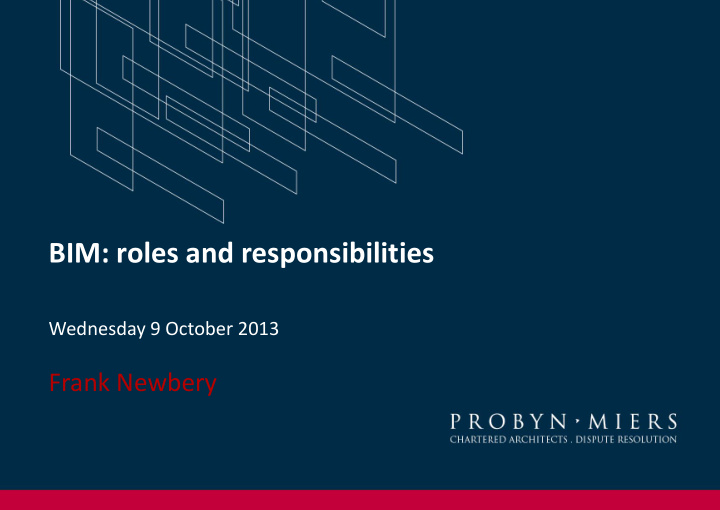



BIM: roles and responsibilities Wednesday 9 October 2013 Frank Newbery
Government Construction Strategy, May 2011: 2.32 “Government will require fully collaborative 3D BIM (with all project and asset information, documentation and data being electronic) as a minimum by 2016.” BIM Working Party Strategy Paper, March 2011: 5.1 “…It is a key recommendation that all public procurement should be carried out at Level 2 or higher by the conclusion of the five year strategy…”
BIM “LEVEL 2” BIM “LEVEL 3” Designer 1 Designer 2 Designer 3 Designer 1 Designer 2 Designer 3 Each designer produces a separate model All designers work on the same single model Separate responsibilities for the model’s characteristics are harder to define & trace The models can be federated and separated Federated Single model model
CIC BIM PROTOCOL Contract 1 The protocol is Appendix 1: to be annexed Model Production in identical & Delivery Table Contract 2 form to all of the project’s building & Appendix 2: Contract 3 professional Information appointment Requirements Contract 4 contracts.
Outline Scope of Services for the Role of Information Management Best Practice Guide for Professional Indemnity Insurance when Using Building Information Models PAS 1192- 2: 2013 Specification for information management for the capital/delivery phase of construction projects using BIM. How to use BIM with NEC3 Contracts Employer’s Information Requirements - Core Content and Guidance Notes
Bim Task PAS 1192-2 Group Guidance - includes Level of Definition criteria BIM Protocol Appendix 2 BIM Protocol Appendix 1 Information Requirements Model Production & Delivery Table (MPDT) Employer’s Information Requirements - Core Content and Guidance Notes
Government Soft Landings Guidance April 2013: “Government Soft Landings (GSL) is a key element of the design and construction process maintaining the ‘golden thread’ of the building purpose through to delivery and operation, with early engagement of the end user and inclusion of a GSL champion on the project team, and commitment to aftercare post construction.”
EVOLUTION OR REVOLUTION?! BIM’s need for early and full project coordination will tend to: - 1. Normalise early involvement of main contractors, e.g. by two-stage tendering or full design/build. 2. Encourage further integration between building and professional appointment contracts and/or more prevalent use of “partnering” contracts such as ACA’s PPC2000 and JCT’s Constructing Excellence. 3. Motivate the formation of multi-disciplinary design practices. 4. Require earlier/greater concern from designers for buildability. 5. Require professionals to review fee structuring to reflect higher proportion of earlier work.
EVOLUTION OR REVOLUTION?! Increasing BIM engagement with post-occupancy requirements and feedback will tend to:- 1. Require more detailed and effective liaison between designers and end users. 2. Require earlier/greater concern from designers for operational performance issues such as durability, running costs, replaceability and accessibility. 3. Inject current BIM practices with methods and techniques already established in Facilities Management. Cobie data format may have to evolve.
Recommend
More recommend